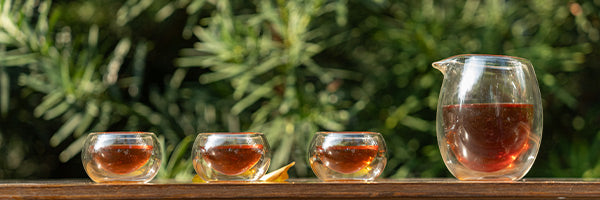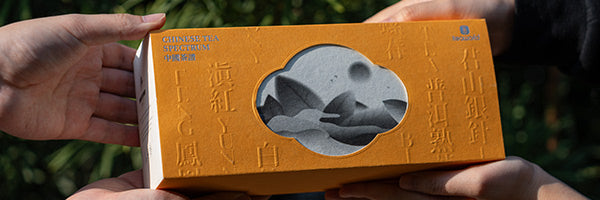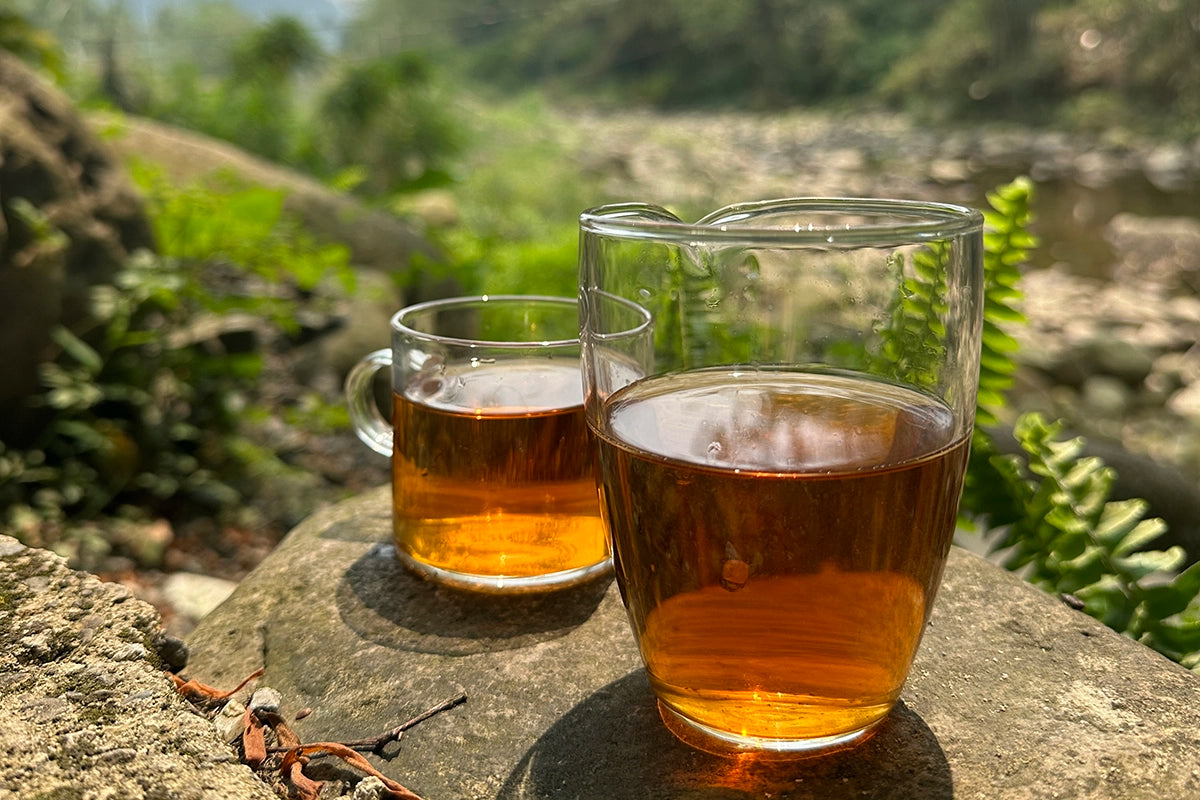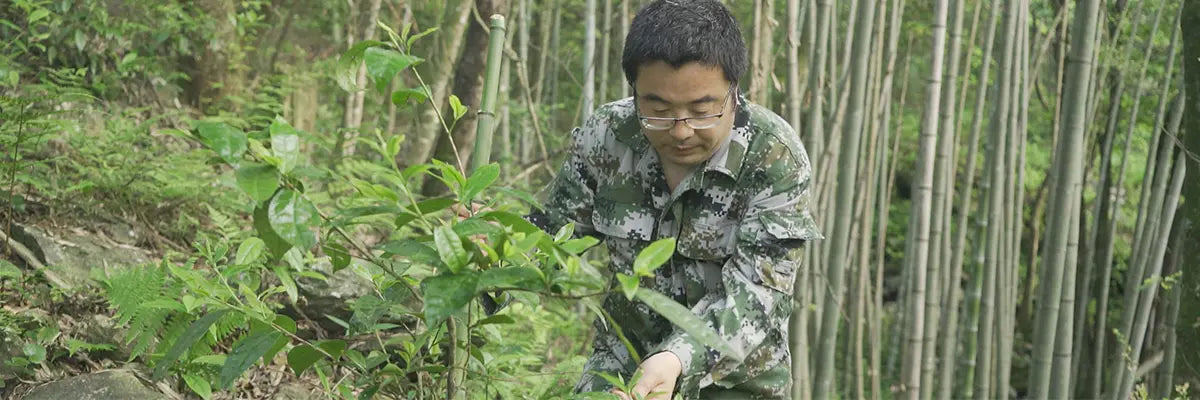Звучит здорово, не правда ли?
На самом деле ситуация может быть гораздо сложнее, по крайней мере, когда речь идет о китайском диком чае .
Что означает дикий чай в Китае?

Если вы окажетесь рядом с искусственно выращенными чайными плантациями, вероятность встретить дикие чайные деревья будет выше. Почему?
Потому что часто существует связь между дикими чайными деревьями и чайными деревьями в местных садах. В некоторых местах некоторые чайные деревья в местных чайных садах выращиваются из этих диких чайных деревьев, и таких случаев много в Юньнани, регионе, известном производством китайского чая . В других местах эта ситуация еще более распространена, где местные дикие чайные деревья когда-то были частью управляемых садов, но позже были заброшены. В результате эти деревья растут естественным образом в дикой природе в течение многих лет.
В целом, под дикими чайными деревьями в Китае подразумеваются чайные деревья, растущие в дикой природе без вмешательства или управления со стороны человека.
Как дикие чайные деревья избегают укусов насекомых, если за ними не ухаживать?
- Укусы насекомых не представляют опасности.
В результате на листьях диких чайных деревьев часто можно увидеть множество отверстий от насекомых. Иногда даже свежесорванные листья могут иметь отверстия от насекомых. Но это не является серьезной проблемой. Существует известный тайваньский улун под названием Oriental Beauty, особенно известный своим уникальным ароматом и вкусом, достигаемым за счет укусов насекомых на чайных листьях.

- Фермеры могут осуществлять простой уход за дикими чайными деревьями.
Есть ли вероятность, что кто-то распылит пестициды на дикие чайные деревья? Такая ситуация возможна, но маловероятна. Поскольку многие фермеры в настоящее время собирают дикий чай для собственного чаепития.

Как правило, вероятность содержания пестицидов и удобрений в диком чае намного ниже, чем в чае из управляемых чайных плантаций. При покупке дикого чая важно проверить наличие сертификатов от профессиональных организаций, чтобы убедиться, что вы покупаете настоящий китайский органический листовой чай .
Как собирают дикий чай?

Некоторые дикие чайные деревья произошли от чайных деревьев в управляемых садах. Эти деревья, как правило, растут в более концентрированных областях, что делает сбор урожая несколько проще.
С другой стороны, сбор диких чайных деревьев, разбросанных по лесам, более сложен. Сборщикам приходится долго идти по лесу. В лесу вы также можете столкнуться с некоторыми необычными спутниками, такими как змеи, поэтому в такие моменты нужно быть особенно осторожным.
Какие сложности возникают при переработке дикого чая?
- Неправильные свежие листья

Поэтому свежие листья с диких чайных деревьев не могут быть такими же однородными по спецификации, как листья с управляемых чайных плантаций, например, полные почки или спецификации с одной почкой и одним листом. Неравномерность свежих листьев означает, что обработка дикого чая включает в себя больше случайности и неопределенности.
- Свежие листья с неожиданным содержанием влаги

Например, если чайный мастер хочет приготовить листовой зеленый чай , обычная температура и время обжарки чая могут оказаться неэффективными для листьев дикого чая. Если чайный мастер использует свежие листья с диких чайных деревьев для приготовления листового улуна , время и интенсивность основного этапа обработки Яоцин (встряхивание) также должны быть соответствующим образом скорректированы. Результат Яоцин (встряхивания) напрямую определяет успех приготовления листового улуна, что имеет решающее значение для производства наилучшего возможного чая улун .
Стоит ли тратить усилия на сбор и выращивание дикого чая?
В Китае, хотя урожайность дикого чая невелика, он всегда был популярен. Из нашего опыта дегустации дикого чая, он выделяется ароматом и вкусом. Некоторые люди предпочитают известные китайские чаи, такие как Лунцзин, Да Хун Пао и Те Гуаньинь, в то время как другие ценят уникальный вкус дикого чая. Если вы хотите попробовать вкус лучшего листового чая , попробуйте дикий чай.
Кроме того, что завораживает в диком чае, так это его дикое очарование, которое субъективно. Некоторые люди считают, что дикий чай обладает уникальным диким очарованием, в то время как другие находят это чувство слишком тонким, чтобы его можно было различить.
Если вы хотите ощутить это дикое очарование, вы можете сравнить дикий чай с садовым чаем, приготовленным с использованием тех же методов обработки. Садовый чай, как правило, имеет сбалансированный вкус на разных уровнях, тогда как дикий чай также имеет соответствующие уровни вкуса, но в менее сбалансированной, нерегулярной и иногда даже грубой манере. Если у вас есть друзья, которые являются любителями чая, вы можете выбрать подарочные наборы чая, включающие дикий чай для своих друзей. Ваши друзья будут приятно удивлены, получив дикий чай.

Китайский чай предлагает широкий выбор видов, не только дикий чай; доступно множество интересных сортов. Не стесняйтесь исследовать мир китайского чая с помощью пробника листового чая .
Мы надеемся, что этот рассказ о диком чае помог вам узнать больше о чае и понять истории, стоящие за этими восхитительными сортами чая.











































































